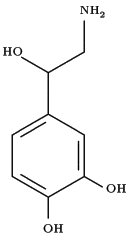Norepinephrine

Norepinephrine (INN) or noradrenaline (BAN) is a catecholamine and a phenethylamine with chemical formula C8H11NO3. The natural stereoisomer is L-(−)-(R)-norepinephrine. It is released from the medulla of the adrenal glands as a hormone into the blood, but it is also a neurotransmitter in the nervous system where it is released from noradrenergic neurons during synaptic transmission. As a stress hormone, it affects parts of the human brain where attention and impulsivity are controlled. Along with epinephrine, this compound affects the fight-or-flight response, activating the sympathetic nervous system to directly increase heart rate, release energy from fat, and increase muscle readiness.
The host of physiological changes activated by a stressful event are unleashed in part by activation of a nucleus in the brain stem called the locus ceruleus. This nucleus is the origin of most norepinephrine pathways in the brain. Neurons using norepinephrine as their neurotransmitter project bilaterally from the locus ceruleus along distinct pathways to the cerebral cortex, limbic system, and the spinal cord, among other projections.
At synapses it acts on both alpha and beta adrenoreceptors.
Function in the brain: attention
Norepinephrine, along with dopamine, has come to be recognized as playing a large role in attention and focus. For people with ADD/ADHD, psychostimulant medications such as Ritalin/Concerta (methylphenidate), Dexedrine (dextroamphetamine), and Adderall (a racemic mixture of amphetamine salts) are prescribed to help increase levels of norepinephrine and dopamine. Strattera (atomoxetine), a selective norepinephrine reuptake inhibitor, is a unique ADD/ADHD medication, as it affects only norepinephrine, rather than dopamine. As a result, Strattera has a lower abuse potential and can act 24 hours-per-day. However, it may not be as effective as the psychostimulants are with many people who have ADD/ADHD. Consulting with a physician is needed to find the appropriate medication and dosage. (It should be noted that some antidepressants, including SNRIs, have been used off-label for treatment of ADD/ADHD.)
Antidepressants
Changes in the norepinephrine system are implicated in depression. Serotonin-norepinephrine reuptake inhibitors (SNRIs) treat depression by increasing the amount of serotonin and norepinephrine available to postsynaptic cells in the brain. There is some recent evidence showing that the norepinephrine transporter also normally transports some dopamine as well, implying that SNRIs may also increase dopamine transmission. This is because SNRIs work by preventing the serotonin and norepinephrine transporter from taking their respective neurotransmitters back to their storage vesicles for later use. If the norepinephrine transporter normally recycles some dopamine too, then SNRIs will also enhance dopaminergic transmission. Therefore, the antidepressant effects associated with increasing norepinephrine levels may also be partly or largely due to the concurrent increase in dopamine (particularly in the prefrontal cortex).
Some other antidepressants (for example some tricyclic antidepressants (TCAs)) affect norepinephrine as well, in some cases without affecting other neurotransmitters (at least not directly).
Clinical use
Norepinephrine (commonly referred to by the brand name Levophed) is also a powerful medicine used in critically-ill patients as a vasopressor. It is given intravenously and acts on both alpha-1 adrenergic receptors to cause vasoconstriction and beta-1 adrenergic receptors to increase heart rate, stroke volume and cardiac output. The net effect is to increase blood pressure. Norepinephrine is mainly used to treat patients in septic shock and has shown a survival benefit over dopamine.
Biosynthesis
Norepinephrine is synthesized by a series of enzymatic steps in the adrenal medulla from the amino acid tyrosine. The first reaction is the oxidation into dihydroxyphenylalanine (L-DOPA), followed by decarboxylation into the neurotransmitter dopamine, and the final β-oxidation into norepinephrine. Norepinephrine can be further methylated by phenylethanolamnine N-methyltransferase to epinephrine (called adrenaline outside the USA).
Metabolites
In mammals noradrenaline is rapidly degraded to various metabolites. The principle metabolites are:
- Normetanephrine (via the enzyme catechol-O-methyl transferase, COMT)
- 3,4-Dihydroxymandelic acid (via monoamine oxidase, MAO)
- 3-Methoxy-4-hydroxymandelic acid (via MAO)
- 3-Methoxy-4-hydroxyphenylglycol (via MAO)
- Epinephrine (via N-metylotransferase (source "Endokrynologia Kliniczna" ISBN 83-200-0815-8, page 502))
